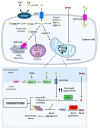Cuproptosis: A Review on Mechanisms, Role in Solid and Hematological Tumors, and Association with Viral Infections
- PMID: 40636277
- PMCID: PMC12240258
- DOI: 10.4084/MJHID.2025.052
Cuproptosis: A Review on Mechanisms, Role in Solid and Hematological Tumors, and Association with Viral Infections
Abstract
Cuproptosis is a distinct modality of regulated cell death precipitated by an overload of intracellular copper, critically dependent on mitochondrial respiration. The underlying mechanism involves the direct interaction of copper ions with lipoylated components integral to the mitochondrial tricarboxylic acid (TCA) cycle. This binding event triggers the aggregation of these proteins, induces significant proteotoxic stress, and leads to the depletion of essential iron-sulfur cluster proteins, culminating in cell demise. Given that copper homeostasis is frequently dysregulated within cancer cells, rendering them potentially more susceptible to copper-induced toxicity, cuproptosis has rapidly become a focal point of oncological research. This systematic review meticulously analyzes and synthesizes findings from a curated collection of 45 research articles. It aims to provide a comprehensive description of the molecular intricacies of cuproptosis, explore its documented associations with a spectrum of solid tumors (including gastric, lung, liver, neuroblastoma, and ovarian cancers) and lymphoma, and examine its emerging connections with viral infections like COVID-19 and pseudorabies virus. The review elaborates on the reported prognostic significance of cuproptosis-related genes and associated pathways across various malignancies. Furthermore, it details the burgeoning therapeutic strategies designed to harness cuproptosis, encompassing the application of copper ionophores, the development of sophisticated nanomedicine platforms, and synergistic approaches that combine cuproptosis induction with immunotherapy, chemotherapy, or sonodynamic therapy. The potential clinical utility of cuproptosis-associated biomarkers for predicting patient prognosis and therapeutic response is discussed based on the evidence presented in the reviewed literature.
Keywords: Cuproptosis; Lymphoma; Solid tumors.
Conflict of interest statement
Competing interests: The authors declare no competing interest.
Figures

Similar articles
-
Cuproptosis: a novel therapeutic mechanism in lung cancer.Cancer Cell Int. 2025 Jun 24;25(1):231. doi: 10.1186/s12935-025-03864-1. Cancer Cell Int. 2025. PMID: 40555995 Free PMC article. Review.
-
Cuproptosis as the new kryptonite of cancer: a copper-dependent novel cell death mechanism with promising implications for the treatment of hepatocellular carcinoma.J Cancer Res Clin Oncol. 2023 Dec;149(19):17663-17670. doi: 10.1007/s00432-023-05456-w. Epub 2023 Oct 16. J Cancer Res Clin Oncol. 2023. PMID: 37843555 Free PMC article. Review.
-
Cuproptosis: Mechanisms, biological significance, and advances in disease treatment-A systematic review.CNS Neurosci Ther. 2024 Sep;30(9):e70039. doi: 10.1111/cns.70039. CNS Neurosci Ther. 2024. PMID: 39267265 Free PMC article.
-
Cuproptosis: mechanisms and nanotherapeutic strategies in cancer and beyond.Chem Soc Rev. 2025 Jun 30;54(13):6282-6334. doi: 10.1039/d5cs00083a. Chem Soc Rev. 2025. PMID: 40433941 Review.
-
A tumor microenvironment-responsive nanocomposite for enhanced copper retention and hypoxia reversal to promote cuproptosis in tumor treatment.Acta Biomater. 2025 Aug;202:463-475. doi: 10.1016/j.actbio.2025.07.013. Epub 2025 Jul 4. Acta Biomater. 2025. PMID: 40618974
References
Publication types
LinkOut - more resources
Full Text Sources

